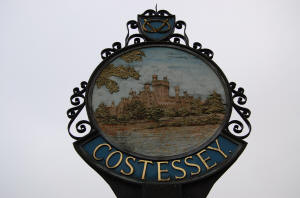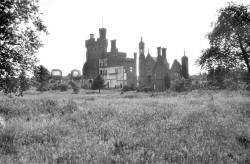|
|
|
|
Costessey
|
| Costessey divides neatly into two areas: the old
part (Old Costessey) which lies inside a loop of the
River Wensum and is full
of character and New Costessey lying to the south which
is a rather unattractive suburban sprawl clustered about
the A1074. In fact, the name Costessey derives from
'Cost's island' or Costessia because the original
settlement was completely encircled by the rivers Wensum
and Tud.

Costessey Village Sign
Showing Costessey Hall
Not surprisingly, it is Old Costessey which contains
the literary connections and, over the centuries, it has
been visited by two particularly fascinating writers:
the first being the writer and physician
John Polidori
(1795-1821) and the second being the Australian poet
Francis Webb (1925-73).
Polidori moved to Norwich in 1817 to set up a medical
practice in the City at the instigation of
William Taylor
when a member of the Martineau family stepped down.
Polidori is best known for being Byron's doctor on his
famous 1816 European tour and for writing the gothic
novel The Vampyre - which was produced at the
Villa Diodati in Switzerland - at the same time that
Mary Shelley wrote Frakenstein.
On the 20th September 1817, while driving through
Costessey, Polidori's gig hit a
tree and the physician was thrown out and landed awkwardly on his head. The accident
rendered him unconscious for four days and when he came
round he wrote the following sonnet - subtitled
'Written in the Album, at Costessey, after my recovery
from an accident, 1817' :
|
Hurl'd from my car
I lay upon the ground,
When death, who comes with rapid step alone
To those for whom joy spreads her gleam around,
Ran to transfix the victim 'fore him thrown.
But soon I saw of two fair forms the hands
Outstretch'd in my defence - like those they seem'd,
Whose breath had caused my happiness - no wands,
No weapons in the air around me gleamed.
Yet death recoil'd - it seemed as if he bowed
Before my guardian's will - perchance he thought
He saw in them, as in the two who brav'd
Awhile his pow'r, the Godhead's image grav'd
So bright; and though majestic, mild it showed,
As if the sov'reign fiat they had bought. |
Although this isn't the most inspirational of sonnets -
it is a fascinating historical record and the accident
proved to be a turning point in Polidori's life as, after it, he never
again prospered. He eventually left
Norwich and returned to London where he ran up serious
gambling debts and died in 1821 from a self-administered
dose of prussic acid. It is likely that he took his own
life - but the coroner returned a verdict of death by
natural causes.Over a century later, Costessey was
visited by another poet - Francis Webb - who at the time
was an in-patient at the David Rice Hospital in
Drayton. Webb
suffered from schizophrenia and persecution mania and
spent most of his adult life in psychiatric care both in
England and Australia. He moved to the David Rice from
Birmingham in 1956 and remained there until 1960.
However, as a devout Catholic Webb was allowed out to
attend mass at the nearest Catholic church - which
happened to be St Walstan's in Old Costessey. Webb used
to walk to the church down Costessey Lane - crossing the
Wensum at Costessey Mill and then turning right up
Costessey Street. As a result of these walks he began
to absorb a great deal about the village's history and geography - which later inspired him to write his amazing
sequence called Around Costessey - which appeared
in the 1964 collection The Ghost of the Cock.
The sequence begins with an historic poem called
Hastings:
|
Pasture, embryo hills,
The Dwelling by the Waterside,
Cotesia, open eye.
Improvident Harold has died:
The two neutral ravenous mills
Munch apathetic rye. |
The sequence then proceeds to explore other historical
characters and locations. Possibly the most spectacular
Costessey-related poem is
The Tower - which
takes as its subject matter one of the remaining towers
of Costessey Hall. The hall, originally built in the
Gothic manner in 1806, house, burnt down in 1925 but its
remains stood for many years - during which time
it was plundered for building materials by local
contractors. Costessey Hall had been the seat of the
Jerningham family - a staunchly Catholic dynasty - who
had helped ensure Queen Mary's succession to the throne
in 1553 and had played a large part in securing the
continuation of Catholicism in Norfolk. Today there is
only one section of the hall left - the Belfry
Tower - which is located on Costessey Golf Course.

Costessey Hall in 1933
© George Plunkett
Catholicism was always an important theme for Webb and
the sequence contains another two poems with a Catholic
connection: the first dedicated to a Jesuit priest called
John Gerald who helped to save Catholics the 16th
Century and the second a more personal poem about the
death of Father Jones who was, presumably, Webb's priest
at St Walstan's.
Another feature of Webb's Norfolk poems is the River
Wensum which crops up in many of them including:
Gale Force,
Beeston Regis and
Derelict Church.
It also appears to great effect in
The Horses
- where he also contemplates its fish:
|
With the Wensum comes consecrated ordered Wish.
From weedy tenements the spying suburban fish.
Dace, roach, carp, dart or loiter with tingling gills
In subaqueous blackout, neon,
Discuss certain shadows, suns as wool or rayon,
Choose certain baits as tranquillisers, pills.
Plucked from his element, each convulsed dreamer beats
Agony for his city streets. |
Webb would have been particularly familiar with the
Wensum valley for the David Rice was built (now
demolished) on the valley side overlooking it.Webb
left Drayton in 1960 and returned to Australia - taking
all of his 'Norfolk' poems with him and they have only
recently come to light thanks to the Australian academic
Toby Davidson - editor of a new collected poems -
who contacted this website. This site is also grateful for
permission to reproduce Webb's poems which was given by
his sister Claudia Snell. |
Links:
More photographs of Costessey
Francis Webb: Norfolk Location Photographs
|
|
|
|

